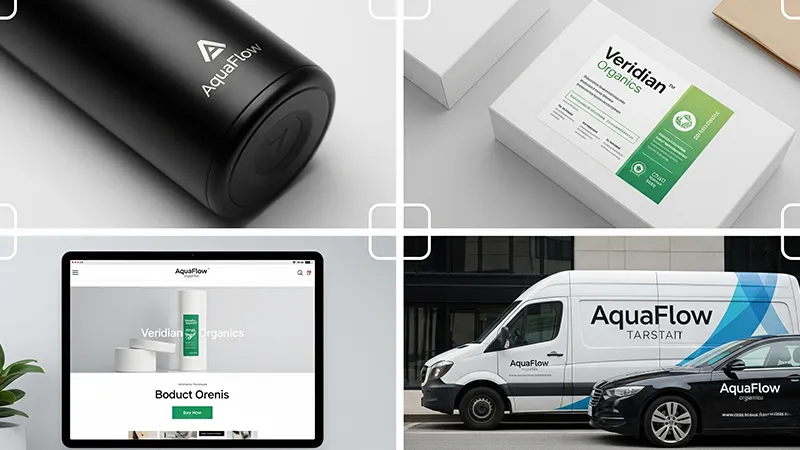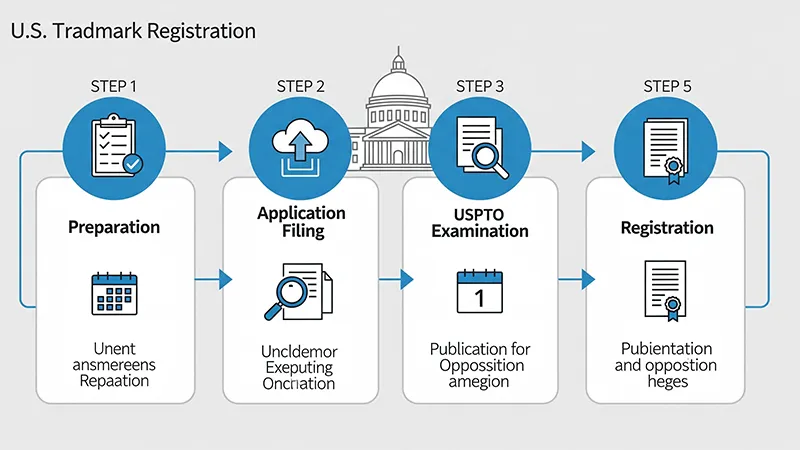the U.S. Trademark Registration Process: A Complete Guide

For Amazon sellers and global e-commerce brands, a united states registered trademark is a cornerstone of brand protection. However, many sellers face challenges with the trademark registration process, from applications being rejected by the USPTO (United States Patent and Trademark Office) to confusion over why a tm agent registration was deemed non-compliant. The process of registering trademark in the U.S. is detailed, and understanding it is key to avoiding pitfalls.
This guide will explore the common questions and precautions for any business looking to register trademark in USA. We'll cover the trademark process from start to finish, from pre-application preparation to the specific requirements for trademark registration, ensuring you have the knowledge to successfully protect your brand.
Overview of the U.S. Trademark Registration Process

The USPTO is the governing authority for all trade mark applications in the United States. The entire trademark application process requires careful attention to detail, especially regarding the evidence of use. Following the correct steps will help you avoid unnecessary detours.
1. Pre-application Preparation
Before you begin filing a trademark with uspto, you must confirm several key details. This includes the trademark itself (word or design), the specific goods or services it will cover, and the applicant's legal name and address. The requirements for trademark also demand you consider the trademark's current or intended commercial use. Thorough preparation here lays a solid foundation for the entire trademark registration uspto journey.
2. Application and Examination Process
Applicants must submit their trademark applications to the USPTO through a U.S.-licensed attorney via the trademark electronic application system. A USPTO examiner will then conduct a comprehensive review. If there are no grounds for refusal, the trademark will be published for opposition.
Currently, due to the USPTO's high caseload, the average hiring timeline uspto from submission to publication is about 10-15 months. The U.S. trademark opposition period is 30 days, though this can be extended. If no opposition is filed and the use requirements are met, the registered trademark application will generally proceed to registration.
3. Understanding the Application Basis
The united states trademark registration system follows a "first-to-use" principle. Applicants must choose one or more bases for their us trademark application, but changing it later may incur extra costs.
| Application Basis | Section | Applicable Scenario | Required Documents/Information |
| Actual Use | 1(a) | Already in commercial use in the U.S. | Actual use evidence; two earliest use dates. |
| Intent to Use | 1(b) | Not yet in commercial use but has a genuine intent to use. | Submit Statement of Use (SOU) within 6 months of approval (extendable). |
| Foreign Registration | 44(e) | Registered in a foreign country for the same goods/services. | Foreign registration certificate with English translation. |
| Foreign Application | 44(d) | Filed a corresponding application in a foreign country. | Priority claim; foreign application and translation. |
-
1(a) Actual Use in Commerce: For trademarks already being used. Evidence must be submitted with the uspto tm application.
-
1(b) Intent to Use: For trademarks not yet in use. After the opposition period, the applicant must submit evidence that use has begun.
-
44(e) Foreign Registration: For trademarks already registered abroad. The us trademarking application must align with the foreign one.
4. Evidence of Use Requirements
A key part of the criteria for trademark registration is submitting a statement of use with evidence. Failure to provide acceptable evidence can affect your trademark's validity. The USPTO's review is increasingly stringent, so applicants should be prepared to provide comprehensive proof.
| Product Evidence | Service Evidence |
| Physical photos showing the trademark on the product. | Catalogs or brochures advertising the services. |
| Product packaging or labels displaying the trademark. | Retail store or restaurant signs with the trademark. |
| Website evidence with product descriptions, the trademark, and a purchase method. | Advertisements, invoices, or business cards. |
| Software (App) store listings showing the trademark. | Photos of branded service vehicles. |
U.S. Trademark Registration FAQs

Here are answers to common questions about how to register trademark in usa.
Is it mandatory to hire an attorney for a US trademark application?
Yes. Since August 3, 2019, foreign businesses or individuals must hire a U.S.-licensed attorney to register trademark uspto. An attorney provides professional legal advice, conducts trademark searches, and handles all USPTO communications.
How can unauthorized agents be identified?
Ensuring your trademark reg us process is compliant is essential. Unauthorized agents may offer services without a law license, use an attorney's name for a fee without providing service, or submit false evidence. Red flags include:
-
The agent only requires you to fill out a questionnaire.
-
Communication is exclusively via email.
-
They make false claims like, "We have a cooperative relationship with the USPTO to expedite your review."
What are the consequences of using unauthorized agents?
Using an unauthorized agent for your federal trademark application can severely affect your business. Consequences include a rejected tm application, unstable validity of a registered mark, or even revocation of an existing trademark.
What if my previously registered trademark did not involve an attorney?
Trademarks registered before the 2019 rule remain valid. However, it is highly advisable to promptly hire a licensed attorney to handle all subsequent processes, such as renewals and submitting evidence of use.
What should I be aware of when acquiring a trademark?
If you plan to purchase a trademark, it is a legal procedure that requires professional support. Before how to purchase trademark, you must conduct due diligence to avoid acquiring an invalid mark. Key considerations include:
-
Trademark Validity: Ensure the trademark is active and was not obtained fraudulently.
-
Goodwill Transfer: In the U.S., the goodwill associated with the trademark must be transferred with it.
-
Due Diligence: Investigate if the trademark is in use, if there are any violations in its file, and if it infringes on the rights of others.
Final Recommendations for Your Trademark Application
When you decide to apply for trademark registration, always remember that a valid ustrademark must be represented by a U.S.-licensed attorney who personally handles the application. Be vigilant about false advertising, avoid suspiciously low-cost agents, and verify your attorney's credentials.
Protecting Your Brand is the First Step
The process of trademark registration is a critical investment in your brand's future. Once your brand is legally protected, the next step is building a resilient and secure supply chain to deliver on your brand's promise. Our end-to-end, one-stop logistics solutions are designed to support growing brands as they scale, managing every aspect from factory to final destination.


